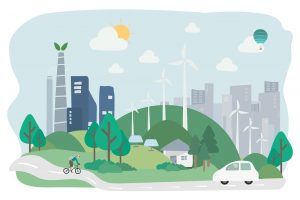The Indonesian government is currently working on a massive 25-year plan to relocate its capital by constructing a new green and smart utopian capital from scratch, named “Nusantara (IKN),” in a rainforest in Borneo located approximately 2,000 km away from Jakarta. Launched in 2019, the project is scheduled to be completed by 2045, coinciding with the centennial anniversary of Indonesia’s founding. However, amidst its promising objectives, significant financial issues have emerged.
This project primarily aims to address socioeconomic disparities and promote development in rural areas. It also aims to mitigate Jakarta’s severe economic, social, and environmental challenges, such as overcrowding, traffic congestion, and pollution. Furthermore, natural disasters, such as floods caused by underground aquifers drained by widespread illegal well digging and rising sea levels due to climate change, are a matter of concern. This project reflects Indonesia’s ambitious vision to become a developed country and fourth-largest economy aligned with SDGs and its commitment to net-zero emissions by 2060.
However, the project’s feasibility has been cast into doubt. Out of the estimated cost of US$32 billion (Rp466 trillion), at least 80% is expected to be financed by external sources, including private and foreign funding through Public-Private Partnerships (PPPs). However, the government is struggling to find financing sources. So far, we know only letters of intent or memorandums of understanding with potential financiers, which are not legally binding.

Image by johnstocker on Freepik
Initially, the funding prospects appeared promising when SoftBank Group (SBG) expressed in 2020 an interest in investing about US$30-40 billion. However, in 2022, SBG unexpectedly withdrew, offering no further explanation. As a result, the Indonesian government turned to seeking investments from Middle East countries like Saudi Arabia and UAE, as well as China. Indonesia and Middle East countries’ relationship is expected to be strengthened as they share common economic and political interests. As for Indonesia, the “oil money” from these Middle East countries is desperately needed for financing. Middle East countries aim to de-risk and diversify trade partners amid tensions between the U.S. and China. For them, Indonesia is attractive because it has a growing economy and shares a Muslim identity.
While the amount of investment specifically for Nusantara has yet to be finalized, China has been influential through investments in Indonesia in the context of the Belt and Road Initiative (BRI). China has already been investing in the green industrial park (KIPI) near Nusantara for batteries for Electric Vehicles (EV) and hydroelectric power plants since 2008, as well as the Jakarta-Bandung High-Speed Railway in Jawa Island. In terms of the digital infrastructure of Nusantara, Huawei, a Chinese firm, expressed its strong interest. As Indonesia demands funding for development, China offers ideal investments, which now accumulated to US$31 billion from 2014 to 2022. For China, a more robust economic tie with Indonesia is critical, especially since the Indo-Pacific region, where Indonesia is located, is one of the critical hegemonic and security competitive regions between China and the US.
Despite the UAE and China emerging as important partners, Indonesia promotes open and balanced relationships with numerous nations. Investors from countries like Japan, South Korea, Singapore, Australia, and Taiwan, as well as international institutions like UNDP and ADB, have recently displayed favorable inclinations toward the sustainable, smart, and green concept, thereby signing letters of intent or memorandums of understanding. However, these agreements lack legal enforceability. Hence, these investors remain cautiously observant of the project’s progress.
Although the increase of the countries with interest may provide some assurance, the prospect of how financing needs would be fulfilled remains uncertain. The government aims to attract investors by highlighting the potential profitability with many incentives. Investors are concerned about the project’s long-term sustainability, political volatility, and transparency. Keen attention is paid to the results of the upcoming presidential election in February 2024. Investors wait to see if the new candidate will continue the project since many regard this project as President Jokowi’s legacy.
Nevertheless, even if the next president takes over the project, a potential risk remains that it could be withdrawn and unfinished depending on the international and domestic situations within the long project timeframe. Who knows what the world’s political economy and environmental conditions will be in 25 years? The current concept of a “smart city” envisioned for 2045 could be outdated.
The project also poses serious environmental and human rights issues. Environmental groups claim that the environmental impact assessment has not been seen, and they warn about the serious destruction of Kalimantan’s natural habitat, a home for endangered species like orangutans. The Indigenous People’s Alliance of Nusantara (AMAN) also estimates that at least 20,000 Indigenous people will be forced to be relocated from their lands due to the new capital.
Even if the political functions can be transferred to Nusantara, more is needed to alleviate the fundamental problem of the natural disaster risks faced by the people who will continue to live in Jakarta. Also, even if Nusantara is established, without jobs, cultures, educational opportunities, and, more importantly, a community, people would not be motivated to move and enjoy their life in the new capital. The willingness and consent of all Indonesian people involved are crucial for its success. Cities would only be functional, livable, and sustainable with a vibrant community and economic and cultural activities.
To achieve successful relocation against these risks, the project should be carried out through three pillars: (1) a comprehensive plan of creating the new capital and relocating the capital’s functions, (2) a plan of renovating the old Jakarta, and (3) social and environmental protection measures for those displaced (e.g. compensation). The government must take the leadership and initiative in implementing these pillars, particularly in addressing the concerns of the affected communities and protecting the environment. How the government designs the PPP scheme and de-risking financially are critical for its success. While countries in the Middle East and China may provide immediate financing, it is essential to evaluate the city’s future and sustainability from the long-term perspective and achieve the Indonesian people’s well-being.
Whether the project saves Indonesia from sinking or puts it into a debt trap remains to be seen. Nusantara may become a modern-day “Noah’s Ark,” leaving people behind sinking Jakarta. While climate change seems not to wait for us any longer, I earnestly wish for the vibrant Jakarta that I love and where my Indonesian friends live. However, the Nusantara does show important messages and will for a green transition to the world. I sincerely hope that the government of Indonesia will overcome these risks and give Indonesia and the rest of the world a better future.
*Title image: Joko Widodo checking the construction progress of Sumbu Kebangsaan, November 2023. Future presidential palace and complex can be seen on the background. (Credit: President of the Republic of Indonesia | BPMI President’s Secretariat/Vico)
This student blogpost was originally written as an assignment for the course “Asia’s Geoeconomic Landscapes and Public Policy I” offered in the academic year 2023 and updated in September 2023, representing the author’s personal views on the subject. The author was inspired and benefited from a discussion with her classmates, Prof. Shiro Armstrong from the Australian National University’s Crawford School of Public Policy and Prof. Toshiro Nishizawa from GraSPP.






